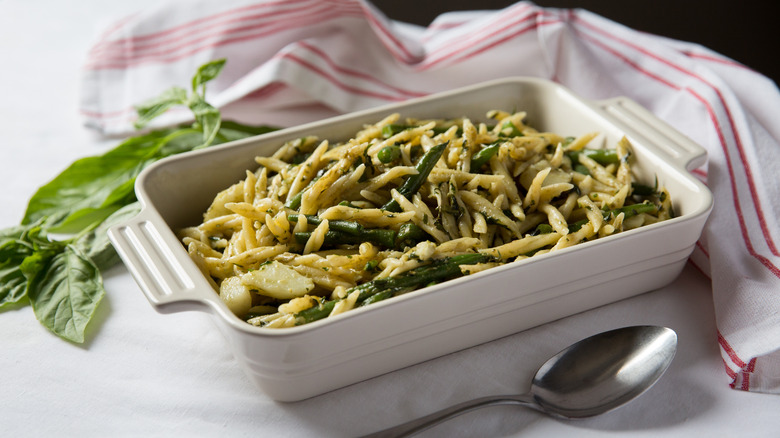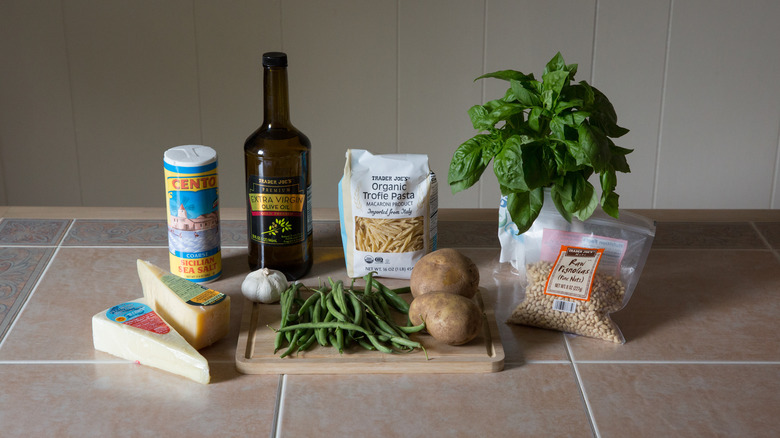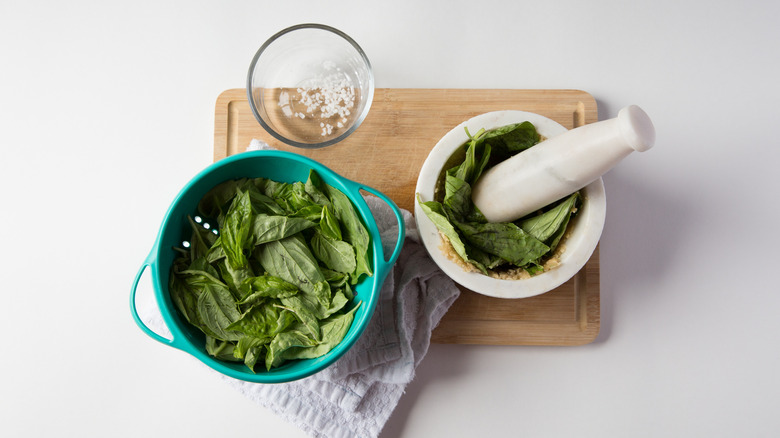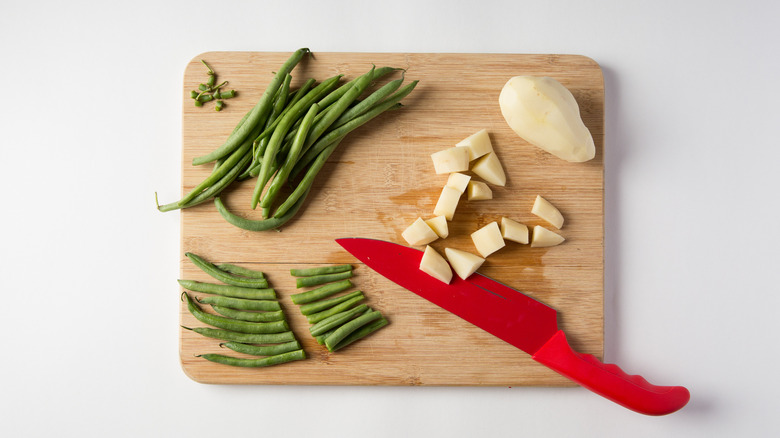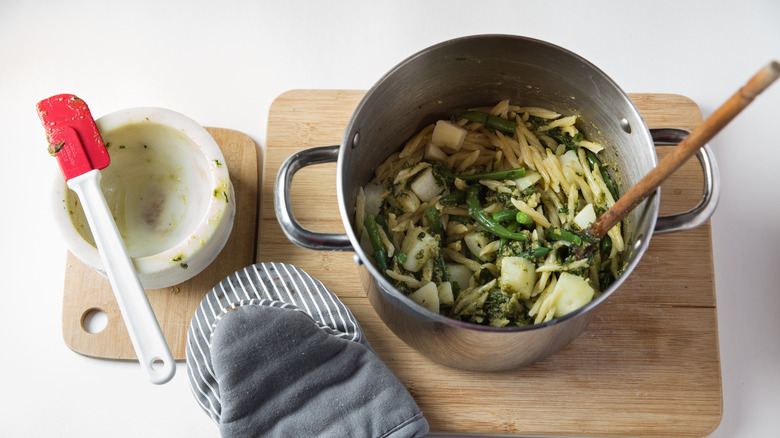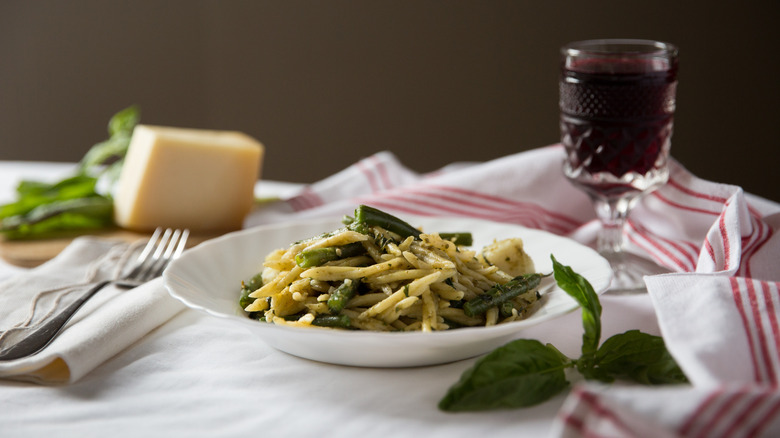Ligurian Pesto Pasta Recipe
If you've only eaten store-bought pesto before, you're in for a treat. Making pesto by hand with fresh ingredients will reward you with sensational aroma and flavor you didn't know you were missing. Classic pesto alla genovese is made by crushing six ingredients by hand in a mortar and pestle: garlic, pine nuts, basil, salt, grated cheese, and extra virgin olive oil.
This recipe developed by Michelle Bottalico brings us a version of pesto that's popular in trattorias all over the Italian region of Liguria. There, it's served with potatoes and green beans, which is a delicious way to enjoy the herby sauce. The green beans add sweetness, and the potato starch released into the pasta water adds another level of creaminess to the already decadent dish. In fact, this version is called pesto avvantaggiato (meaning "with an advantage" in Italian), because the vegetables add a richer flavor compared to simple pesto. It's traditionally served with trenette or trofie, two pasta shapes that hail from Liguria.
Using a mortar and pestle requires a little more time and muscle, but you'll preserve the purest flavor as well as the rustic graininess of the original dish. But don't worry: You can make it in a food processor if needed. Since the potatoes, green beans, and pasta cook in the same water, you'll only have to wash one pot. Read on to learn how to make this rich and creamy pesto in under an hour.
Gather the ingredients for Ligurian pesto pasta
For the pesto, you will need basil, garlic, pine nuts, coarse salt, Parmigiano Reggiano and pecorino cheeses, and extra virgin olive oil. The key to homemade pesto's pure, intense flavor is to use the best ingredients possible. Ligurians make pesto with the prized, small-leaved Genoese DOP basil, which grows on balconies all over Genoa's narrow, ancient streets. Any basil will work well, but choose the freshest you can find, with unblemished leaves. If you don't have pine nuts, you can use walnuts or almonds in their place. While Italian recipes often call for Parmigiano aged 24 months and pecorino sardo, any version of those cheeses can be used, but avoid those with additives or anti-caking agents, which will change the texture of the final dish. Equally important is to use the best quality extra virgin olive oil you can reasonably procure, because the quantity is generous, and you will taste it. If you would enjoy the taste of the olive oil soaked on bread, it will be great here.
Next, gather potatoes, green beans, and pasta. Russet potatoes or any kind of potato you would use for baking will work. If you can, choose a Ligurian pasta like trofie. The spiral shape traps sauce, delivering more flavor with each bite. However, any pasta shape with nooks and crannies, like casarecce or fusilli, will do the same.
Grind the pesto ingredients
To make the pesto, you will crush the ingredients in a mortar and pestle. First grind the garlic and pine nuts until they're finely broken up and no big pieces remain. Don't be too enthusiastic here, or you might end up with nut butter or pooling liquid. Then add the basil (carefully washed and dried) and salt and grind until it forms a paste. Depending on the size of your mortar, you may need to add the basil leaves a little at a time. Use the pestle to evenly mix the cheese in next, and then slowly pour in the olive oil and stir the mixture well with a spoon. It should look very oily. Set the pesto aside.
For these steps, make sure to move the pestle against the walls of the mortar in a circular motion rather than pounding it on the bottom. This will prevent anything sticking to the bottom or being overly crushed. Most importantly, it will tear the basil leaves slowly, better infusing their aroma into the sauce. If you use a food processor, use fine salt instead of coarse and add the nuts last so they don't get overprocessed. Only pulse the mixture as much as you need to make it come together. This will prevent the heat of the blade from oxidizing and darkening the basil or making the pesto too smooth. For best results, freeze the bowl and blade for an hour ahead of time.
Prepare the potatoes, green beans, and pasta
After you wash the vegetables and peel the potatoes, cut the potatoes into nice bite-sized cubes no longer than ¾ inch. Then cut the stems off the green beans and cut them in half. Once you've brought a large pot of salted water to a boil, first add the potatoes, and then after 2 minutes add the green beans and trofie. Stir and let everything boil for 10 more minutes until the pasta is al dente. The timing is important here since the vegetables and pasta boil in the same water but with different cooking times. The potatoes boil for 12 minutes and the green beans and trofie for 10. Check the package, and if the pasta shape you use has a different cooking time, change the time you add it to the water.
Drain the pasta and mix everything together
Right before the pasta finishes cooking, scoop out about ¼ cup of the cooking water and set it aside. After draining the contents, return them to the now empty pot. Add the pesto and gently mix it into the pasta and vegetables with a wooden spoon. Now is when you'll use the cooking water you saved. Add a little at a time to the mixture; it will help everything mix together more easily. You may not use all of it, so just use as much as you need to coat the pasta evenly.
Serving and storing the pesto
This dish will be most delicious when served as soon as it's mixed, so don't delay. Garnish each dish with a small sprig of fresh basil leaves if you'd like to add extra beauty to your presentation. We recommend making just enough servings of pasta to be eaten in one meal, because the texture and flavor of leftover pesto pasta isn't as enjoyable. If you make extra pesto sauce, however, you can safely store that in the refrigerator for four to five days. Pesto exposed to air will oxidize and turn brown, so to avoid this, store the leftover pesto in a narrow jar or container and pour a little olive oil on top to form a seal.

- 1 bunch packed basil (about 60 leaves)
- 2 cloves garlic, peeled and cut into small pieces
- 3 tablespoons pine nuts
- 1 pinch coarse salt
- ¼ cup grated Parmigiano Reggiano cheese
- 2 tablespoons grated pecorino cheese (ideally pecorino sardo)
- ¼ cup + 2 tablespoons extra virgin olive oil
- 2 small Russet potatoes (½ pound maximum)
- ¼ pound green beans
- 11 ounces dried trofie (or other short twisted pasta)
- Additional basil leaves (for garnish)
- Wash the basil leaves and dry them carefully with a cloth.
- Place the garlic and pine nuts in a mortar and grind them with a pestle until finely ground. Move the pestle in a circular motion against the walls of the mortar rather than pounding the ingredients on the bottom.
- Add the basil and salt. Continue to grind the mixture in a similar manner until it turns into a paste.
- Add both grated cheeses and mix with the pestle, using the same circular method, until the mixture is uniform.
- Slowly pour the olive oil into the basil mixture while stirring continuously with a spoon until well mixed. Set aside.
- Wash and peel the potatoes and cut them into small cubes no more than ¾ inch. Wash the green beans, cut off the stem ends, and cut in half.
- Bring 3 quarts of salted water to a boil. Add the potatoes.
- After 2 minutes, add the green beans and the trofie. Stir so the pasta doesn't stick to the pan. Boil for 10 more minutes or until the pasta is al dente. (The potatoes boil for 12 minutes and the green beans for 10, so if you use a different kind of pasta, read the package directions and adjust the time you add the pasta accordingly.)
- When the pasta is almost done, remove about ¼ cup of the pasta cooking water from the pot and set it aside.
- Drain the pasta and vegetables and return them to the now empty pot. Add the pesto and gently mix everything together with a wooden spoon. Add as much of the reserved cooking water as you need to help coat the pasta evenly with the pesto.
- Serve immediately, garnishing with additional basil leaves if desired.
| Calories per Serving | 643 |
| Total Fat | 29.4 g |
| Saturated Fat | 5.4 g |
| Trans Fat | 0.0 g |
| Cholesterol | 10.6 mg |
| Total Carbohydrates | 77.5 g |
| Dietary Fiber | 4.8 g |
| Total Sugars | 3.8 g |
| Sodium | 209.8 mg |
| Protein | 18.3 g |
